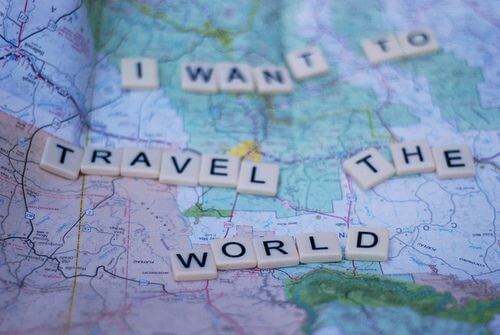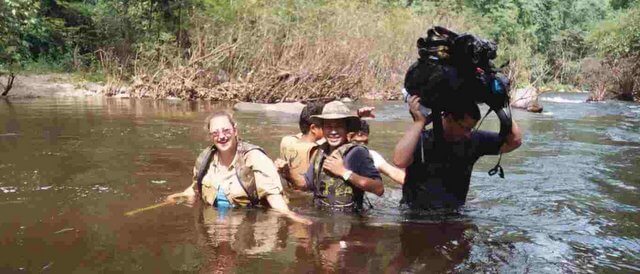Just how much stuff do you need for a year away? Or even an indefinite trip? Remember that whatever you take you’ll have to carry and keep safe, so minimal packing is the best option in almost every department. Nothing distracts more from an easy journey than struggling with heavy luggage every day and the less you’re carrying the more flexible your transport options become.
Apply the old adage that you should take half the luggage you think you’ll need and twice the money.
Note that this post contains a few Amazon affiliate links, mostly for illustration of specialised products. All proceeds go to the CATS Foundation, a Tay-Sachs disease charity of which I’m a patron.

Do it.
General Packing Tips
Firstly you need to research where you’re going – what will the weather be like, how likely are you to be able to buy more equipment where you’re heading, what type of accommodation are you staying in, how often can you do laundry, what sort of plugs will any electrical gear need?
Weather
The UK Meteorological Office has an excellent series of country guides, which will give a simple overview of the weather and lead you to a table of detailed temperatures and rainfall by month.
Accommodation
Are you staying in hotels, pitching tents in organised campsites or getting out there in wild camps?
Hotels and Hostels will be the easiest and require minimal luggage. Even low-end hotels tend to provide guests with shampoo and shower gel.
Quick note about home stays. If you’re lodging with a family and want to chat, nothing breaks the ice faster than a few postcards of home, and maybe photos of your family.
Let’s get down to details:
Luggage
How to carry all this gear?
Backpack: After 4 years on the road the quality I look for most in a bag is ease of access. A top-loading backpack may be comfortable to carry across the mountain, but if all you’re doing is moving between the bus and a hostel it’s rather wasted. Having a bag with multiple opening points means you can keep everything in its place and get to it rapidly, without unpacking each time.
Bear in mind that easy access to you means easy access to pickpockets as well. Always keep an eye on your bag.
It’s important you’re able to carry it when full. Many people get by with 35l for extended periods. I have no bother carrying a 90l, but limit myself to a 55l for convienience – it’s much easier to store when travelling by bus or train. The Osprey Porter 46 is another excellent option and doesn’t have the weight of the wheels.
Day-sack: I use a very small but lightweight 10l pack for day to day walking. It’s large enough to fit a lunch and a camera, and expands enough to accommodate a good-sized coat.
Clothing
There’s a choice between specially designed travel gear, which is light and practical, but instantly marks you out as a tourist, and your usual home clothes which you may feel more comfortable wearing. On a long trip I find a mixture of the two preferable. Hiking in jeans is less than ideal, as is going to a fancy restaurant in zip-off hiking trousers.
Remember that unless you’re a hugely different body shape from the people you’re visiting, you’ll be able to buy clothes almost anywhere. Unwanted clothes can be sent home or donated to local charities.
The key here is coordination, so that whatever you have can be worn in multiple combinations. Darker items hide stains better, whether they are from sweat or lunch.
Shoes: I favour a low-cut hiking shoe for general active wear, and in cities a pair of smarter or smaller shoes for evening wear. Flip-flops or sandals are useful everywhere, from the beach to an unsanitary bathroom.
Socks: Stick to SmartWool. It’s comfortable and fast drying.
Underwear: Usually whatever you wear at home, plus a couple of anti-microbial pairs for long walking days. I favour Helly Hansen, but Ex-Officio are also highly recommended. The Underarmour underwear really didn’t work.
Tops: Mainly t-shirts and shirts. Bring at least one long-sleeved shirt to deter mosquitoes. In hot weather the Columbia Omnifreeze range has been amazing recently.
Trousers: One pair of ‘normal’ trousers for nights out, one pair of (convertible) hiking trousers or a pair of shorts is generally enough. Don’t forget the swimming gear.
Skirts: At least one long one, or a sarong wrap/pair of trousers to cover up in religious locations.
Hats: Much cheaper if bought along the way as the local style is usually best for their climate – often a woolly one for cold weather and a wide-brimmed one for the sun. A strap is useful for windy locations, or one with a neck guard for extreme sun.
When packing clothes for hot weather, be mindful of local customs. A lot of places won’t appreciate short shorts and low cut or sleeveless tops. It’s always useful to carry a sarong or two to cover shoulders and legs when visiting sensitive areas.
Perpetual wet weather is the hardest work, as it’s no fun putting on damp clothes in the morning. In warm wet weather it’s important to keep the upper body dry with a light poncho or packable rain jacket but I find it far easier to just wear shorts and let my legs get wet.
Cold weather is the easiest to accommodate. Just stay dry and layer up all your other clothes. There’s rarely any need for bulky down jackets and salopettes. A long-sleeve moisture-wicking base layer is particularly useful in these conditions and can be worn on its own at temperatures down to zero degrees.
Toiletries/First Aid
Most people take way too much. I carry the bare minimum for emergencies and buy anything else:
- Anti-diarrhea
- Anti-constipation
- Anti-indigestion
- Anti-malarials, if required
- Couple of plasters
- A few headache pills
Be wary of the drug laws of your destination. Always carry the prescription for any medicines you need.
Glasses may be preferable to searching for contact solution in remote areas.
Makeup: As required, but many people end up not worrying in hot weather.
Birth Control: Your local version may not be available.
Sanitary pads: Hard to find in some Asian countries
For toiletries I decant them into smaller bottles and buy more along the way. Put them in a plastic bag to avoid any leakages. With globalisation nearly everything is available everywhere.
Paperwork
Keep these in a waterproof bag, and keep photocopies separately, or take photos/scans and store them in your camera and in a webmail account or Dropbox. Also email yourself the numbers to call in case of lost bank cards or insurance claims.
- Passport
- Record of Immunisations
- Spare passport photos
- Notepad
- Required documentation such as drug prescriptions, driving license or diving logbook
Technology
Over time this is becoming a larger and larger portion of my luggage.
Smartphone, Laptop, netbook or tablets: plus all the power cables and adaptors you need. A laptop is useful if you’re working, otherwise a tablet will usually suffice. A neoprene cover acts as padding and waterproofing. Consider a buying a VPN for added security
Camera: DSLR or point and shoot, along with charging cables and the cable to upload your photos. Spare batteries and memory cards are a good idea. Modern smartphones often have excellent cameras if you’re trying to save weight. A tripod can be useful, but you can often use a nearby wall or your daysack. I use a Canon S100, as the GPS-tagged photos help figure out where I’ve been. The newer S110 is missing the GPS.
edit: I’ve recently upgraded to a Sony RX10 as the built in x25 zoom is amazing, and saves carrying a DLSR + zoom lens.
If you’re a prolific photographer, consider a portable hard-drive to save your work. My Western Digital one has lasted for years. Toughened hard drives are available, but are bulky and weigh more.
Music: An MP3 player is an easy way to carry lots of music/audiobooks to pass the time. Most travel speakers are useless, but it’s worth investing in noise-reducing headphones for long bus/train/plane rides. I use the very lightweight Sennheiser CX300s, but over-ear ones will reduce noise more. Most phones can double as MP3 players but mind the battery usage.
Reading: If audiobooks aren’t your thing, then consider an eBook reader, like a Kindle – the battery lasts for weeks! Failing that, many hostels will have book-swaps.
All-in-one power adaptor (I like to have a USB charger built in): This one works in over 150 countries. If you have a lot of electronics you can use a power strip to get more plug sockets, and will be the hero of your hostel dorm.
General
Head torch: Keeps your hands free whilst putting up tents, reading or during power outages. Invaluable for middle-of-the-night trips to the bathroom while camping.
Sunglasses: The very cheap ones you buy abroad won’t offer any protection against UV rays.
Multi-knife: Scissors, corkscrew, tweezers and a blade are enough. Remember to take it out of your hand luggage when flying.
Travel towel or Sarong: These dry quickly and can double up as a picnic blanket
Silk bed liner: Weighs nothing, but helps avoid bed bugs (and dirty sheets…)
Stuff sacks/dry sacks: to help organise your backpack. If space is at a premium, have a look at compression sacks.
Duct tape: Fixes rucksacks and clothes, covers blisters

My first trip away, in which I rapidly regret packing so much rubbish
Items I have found no use for, in six years of constant travel
- Solar chargers – it was too slow to store up a useful charge
- Fold away duffel bags
- Aluminium water bottle. Just buy a bottle of water, then reuse the bottle
- Knife, fork, spoon, spork, travel chopsticks – if not camping
- A travel mirror
- A money belt – no better way to spot mugging targets
- Travellers Cheques – hard to change in many places
- Rubber bands & String – seemed like a good idea. Use duct tape instead
- Sink plug and washing line – unless you’re wild camping, there will be a laundrette nearby
- Inflatable pillow – roll up a sweater
- Mosquito net – these are usually supplied by the accommodation if needed









Pingback: Dr. Jessica Voigts (@WanderingEds)
Pingback: Steve Juba (@solotravelclubs)
Pingback: Micki & Charles (@BarefootNomads)
Pingback: Maria (@acceleratedstal)
Pingback: Wendy & Sherry (@Kiboomu)
Pingback: Lisa Niver Rajna (@wesaidgotravel)
Pingback: Chris & Tawny (@CaptainandClark)
Pingback: @LoveWriteTravel
Pingback: BlogExpat (@BlogExpat)
I tend to subscribe to the old adage that unless you’re going to some far off-the-grid destination, chances are you’ll be able to get anything you’re missing at the destination. So pack less, and buy it there if need be. Chances are, you’ll discover you won’t need it…
So true. Having spent lots of time in off the grid places, toilet paper/bum wipes are best from the West. I love my disposable $6 Oral-B battery-powered tooth brushes. Other items include nail clippers and shoelaces are small and easy to carry.
Great tips! i agree – and like to try new things when we travel. leave the shampoo home! 🙂
well organized, i like it. not another ‘just a list’ – a great list. wish i had read it before i left….
This is some sound advice and despite everyone who reads it 90% of people will still over pack haha. I think it’s just one of those things that you have to experience for yourself when your hauling it around all day on your back. It does make you quickly come to terms with what you really need and what you thought you needed.
Very true – it’s almost a right-of-passage when you get home from your first trip, to look at all the items you’ve been carrying that have never been used. For me it was the great big SIGG aluminium water bottle. Too expensive to just throw away, not valuable enough to ship home midway.
you can now get aluminum water bottles for free that carry advertising.
Great tips! I think we have similar packing styles. I tend to find I can get by with very little clothing but it’s often the little things like duct tape, first aid kit, flashlight, hand sanitizer and other “just in case” products that take up space. You might be able to find some of these things at your destination, but not necessarily right when you need them and not always at the best quality (e.g. you may or may not trust the local medicinal products when you get that stomach ache).
Useful tips — especially the stuff you don’t need.
Agree! Over packed is very common… 1st time experience, bring bunch of clothes as to make sure enough to wear, after the trip found out many unused clothes.
Lesson, bring clothes washing liquid to wash the used clothes and rewear it 😉